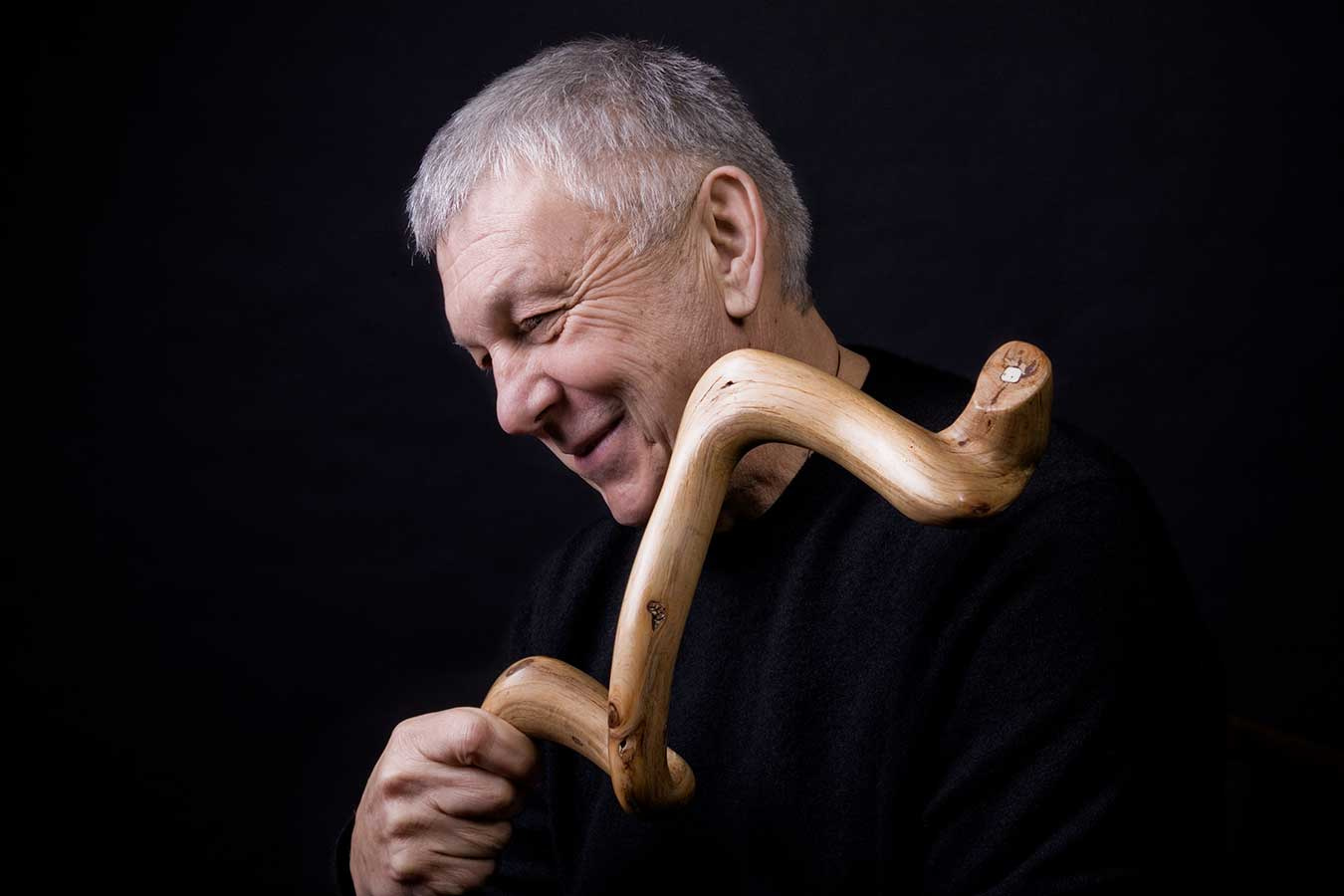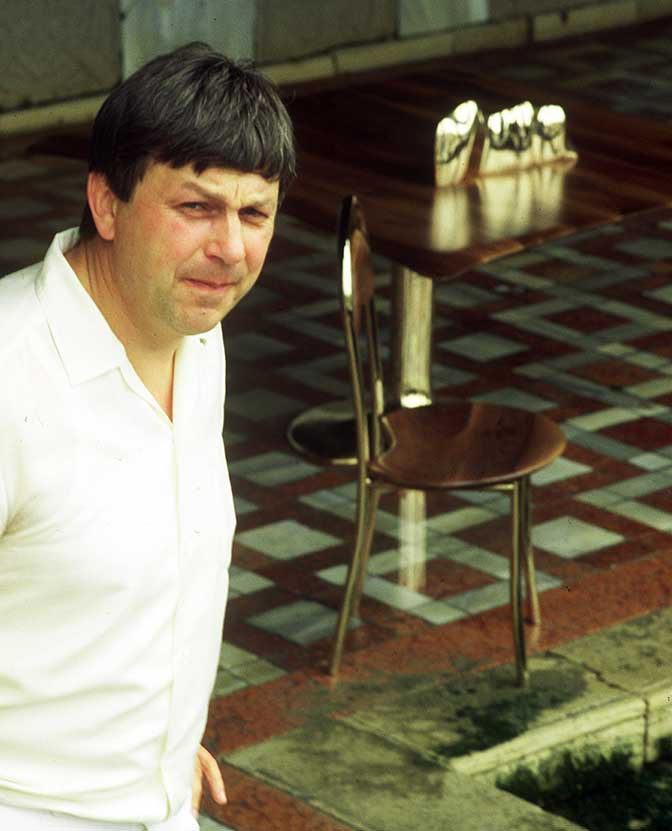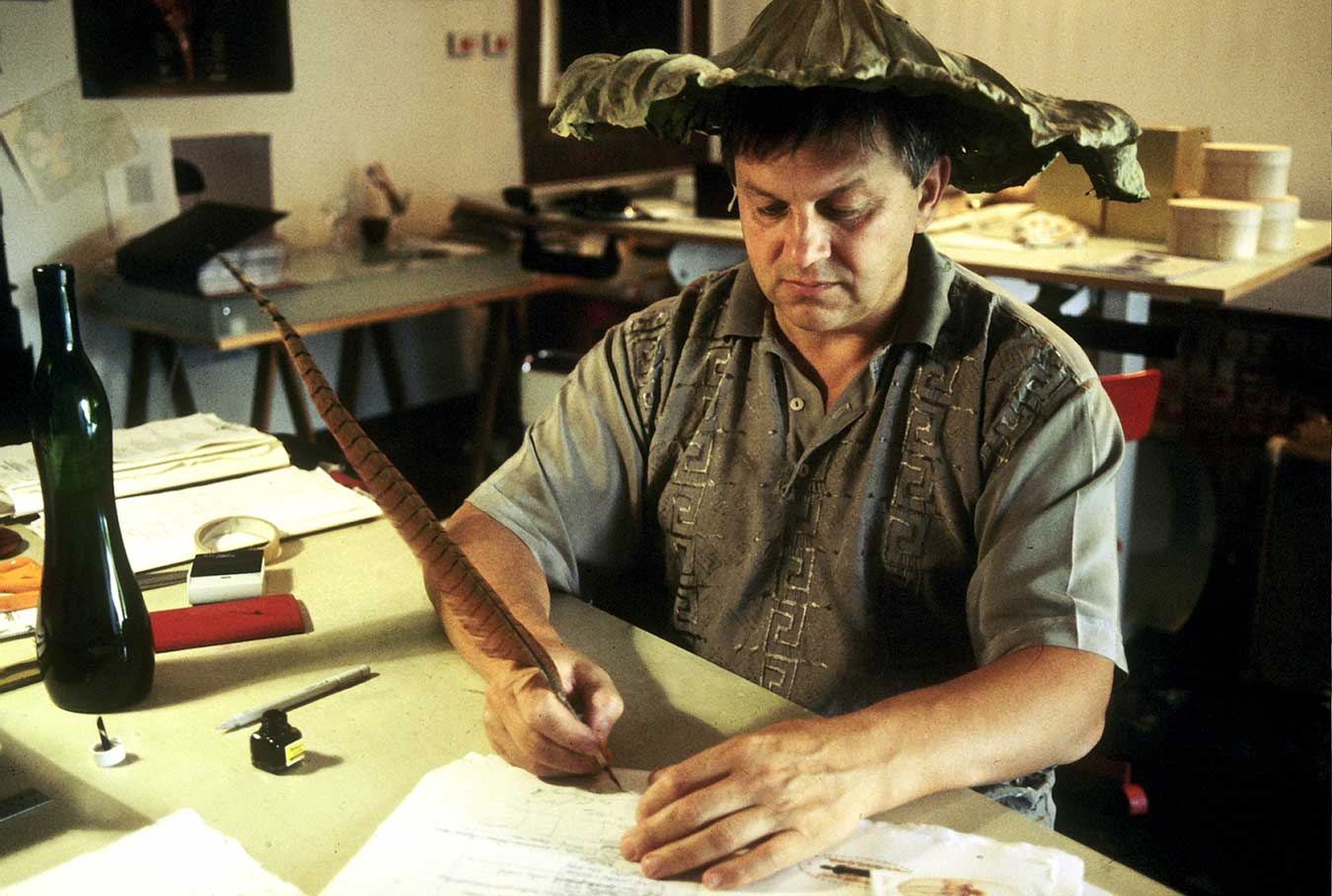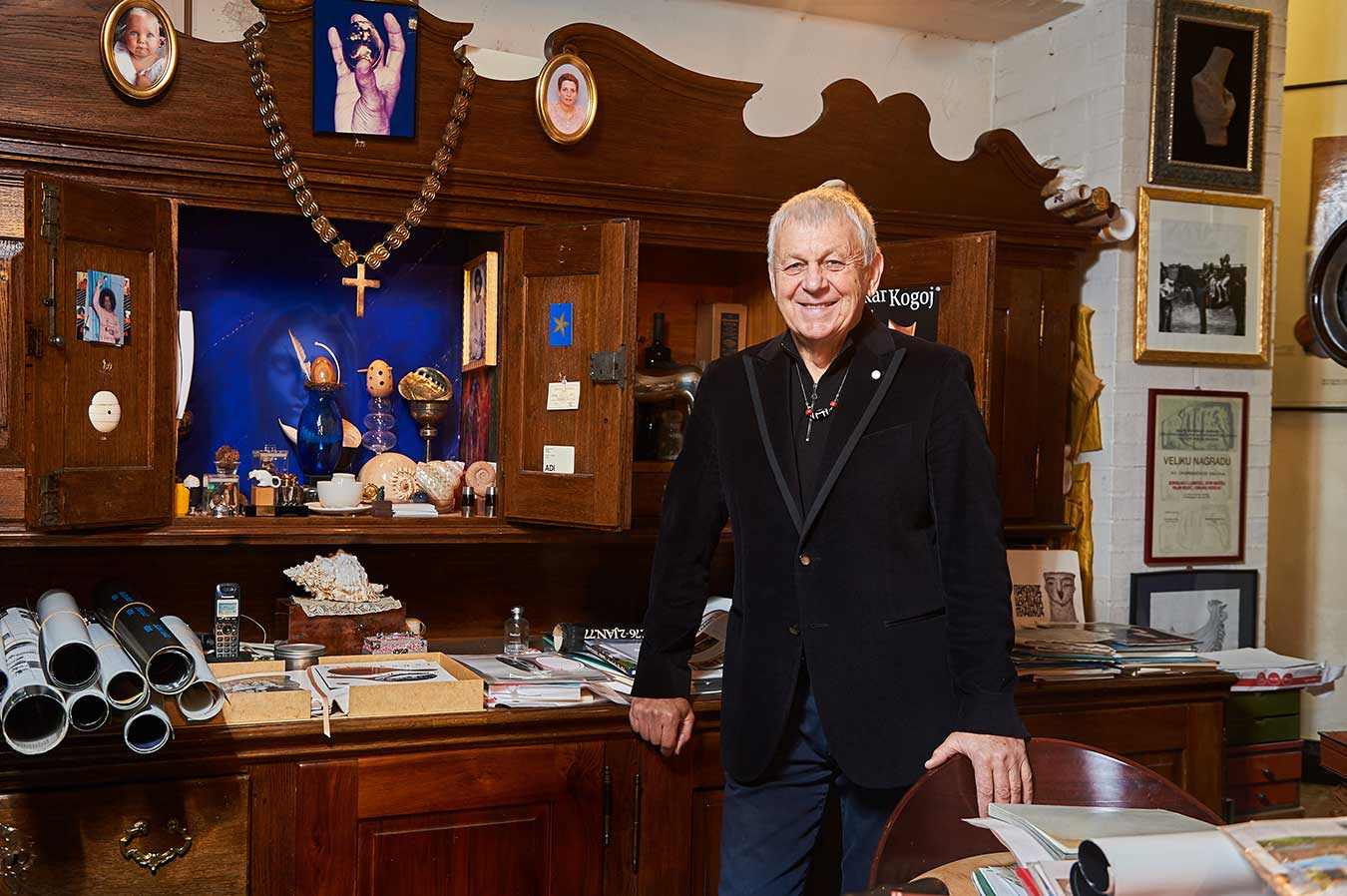Oskar Andrej Kogoj is a locally and globally acclaimed industry designer, artist, member of academia, professor and researcher. He was born on 23 November 1942 to a Slovenian family to his mother Pepca Butkovič and father Milan Kogoj. He was the second child in a family of six children. He comes from Miren near Gorica, where he was born and still lives to this day

His love for the nature is what gives him his creative power to design artworks that connect us with our roots. His products arouse interest and respect for the nature. He is driven by his curiosity and will to use the secretive, valuable and divine gifts of nature and life to design for himself, his friends and everyone who feels and wants to accept his clear forms. These unforgettable forms have found their place not only in the history of local and global design, but also in the souls of people who are in contact with his creations. With his sensitivity and integration of the human soul with the laws of nature, he can link transcendent ideas with the material world. We could say that he uses design as a medium through which he communicates transcendent energies.
Already as a child, he was curious and kept questioning the background of things and object, their origins and ancient symbolic meanings. He studies the cultural heritage and the forgotten knowledge of ancient civilisations, and he is very fond of everything Slovenian. He has travelled a long journey, on which he acquired the knowledge that he now uses to design his products.
He visited primary school (1949–1953) and the then-middle school (1953–1957) in Miren, where he proved to to Dušan Nosan and Franc Jerkič to be a highly skilled painted. Next, he went to high school in Nova Gorica (1957–1960), where he was recognised as the best student in history, the Slovenian language and swimming. In the period 1957–1959 he also visited the Nikolaj Pirnat painting school in Nova Gorica, which was headed by academic painter Rafael Nemec. During that time, he was also taught by his father Milan, a farmer and a butcher, who taught him all about the art of butchery. He helped his father design and construct his butchery in Miren.
In the period 1960–1963, he visited the secondary school of design in Ljubljana, namely the interior design course. He was taught by Bogomila and Marjan Pogačnik, Miloš Poćar and some other Jože Plečnik’s students. In 1962, he created the famous mosaic on the façade of the church in the Castle of Miren, which portrays the Sorrowful Mother of God, under the mentorship of and in line with the drawing of painter Tone Kralj. To this day, the mosaic decorates the entrance to the church. In his third year of secondary school, which was in 1963, Oskar Kogoj was awarded the "gold stopwatch”, which was an award presented to the best students.
Having discovered his true talent, Oskar Kogoj decided to drop out of school in Ljubljana. Accumulating the highest possible score and special accolades, he passed the entrance examinations for his studies, which he pursued at Schola Al Carmini in Venice and Instituto Statale d’Arte – Corso superiore di Disegno Industriale. There, he was taught by G. Mazzariol, M. De Luigi, M. Bellini, P. Torsello, G. Palatini, I. Zannier, V. Lazzari, and others. In 1966, he received a cash prize in the amount of an annual professor's salary for the being the best student, and graduated early with a distinction from industrial design.

| After finishing his studies, he worked as an assistant professor at Istituto Statale d´Arte – Corso superiore di Disegno Industriale in Venice up to the year 1967. Until 1968, he also worked as a counsellor to the Baby Mark company in Milan. From 1968 to 1970, he worked at the R&D department at the furnishing company Meblo in Nova Gorica.
Since 1971, when he received an award of the Prešeren Fund, he has had the status of a freelance artist. In 1973, he enrolled in postgraduate studies in London together with architect Ivo Špinčič – the then-President of the Designers Society of Slovenia. From 1974 to 1976, he headed the Department for Industry Design at Universita Internazionale di Venezia e Firenze.
In 2006, he enrolled in the reputable society of Timeless Slovenian Designers. As a Professor at the University in Nova Gorica, he still passes on the knowledge that he has acquired onto younger generations.
|
He has also studied in France, Germany, Denmark, Sweden, Finland, Russia, Great Britain, the USA, Mexico, Greece, Cyprus, Israel, Egypt, Tunisia, India, Thailand, Japan, etc. He has been taking part in joint exhibitions ever since 1959, and he has held solo exhibitions since 1970. He has participated in more than 400 group and solo exhibitions both in Slovenia and abroad. Since 1969, he has received more than 70 international prizes and awards for his remarkable work. His artworks are exhibited in more than 100 museums and other permanent exhibitions in Slovenia and abroad.
He is a member of international art and design associations, such as ADI, DOS, ICSID, BEDA and ICOGRADA. In 1991, he co-established "Slovenska Dvanajstija” at the Holy Fortunate of Slovenia, which he is still a member of. In 1996, he also became a member Circollo Artistico Veneziano with the number 821.
|
| 
|

As an icon of Slovenian design, he uses his touch and charisma to create unforgettable forms. These go down not only in the history of local and global design, but also in the souls of people in touch with his creations. With his sensitivity for the integration of the human soul with the laws of nature, he transfers ideas from the transcendent to the material world. He imbues his products with timelessness.
With all we have said, we must not forget that he a conscious Slovenian while at the same time remaining open to the world. He is a prominent researcher of ancient civilisations’ forgotten knowledge, a worshiper of nature and a seeker of truth. His spirituality takes form in his unique works.
As he has said himself: "I never start a project as a spiritual newbie. Each of my products is preceded by time-consuming and thoughtful work. I spend months or even years on spiritual research and discussions, which represent the basis of any task I undertake. Only then do I begin collecting the structural elements. Design is the last thing to come – much like a dress is the last thing you put on your body.
I have always sought, and I am still seeking, discovering, identifying and inventing myself without parting myself from the world which I live in. I have found certain answers in the ancient times, in religion and belief, in philosophy and in reality – but I still haven’t discovered everything. When I search, I create – and I create because I search.”
The search for the perfect form or perfection is a lengthy process which defines the human evolution. It can take the form of meditation or search for our inner self – our internal divine content. Even Aristoteles and Plato have said: "Man is the measure of everything! Man is the creation and the creation is man!” Man’s true realisation lies in the recognition of himself or herself. He or she is his or her own creator!”
Form is energy, form is nature and nature is divine creation. Art and design are an expression of the human spiritual being and corresponding inspiration, which the artist always wishes to assign an external form to. This way, they can leave behind a testimony for the generations to follow. At the same time, art is a reflection of the culture and life of a certain nation or civilisation, which reveals itself to us through a visible form in our inner experience and the spiritual world. A spiritual expression with artistic and technical truths, true art and true design can only come from a pure heart.
This is how he describes his work. He is an artist, who deals with designing a variety of different products made of natural materials, in which he uses his findings that are the result of studying ancient cultures – from the Egyptian and Aztec, to the Etruscan, Jewish, Venetian, Epidaurus and Vedic.

Despite his huge success in life, Oskar Kogoj places a strong emphasis on his spiritual side. "Today, the times are different, which means we have to transform in order to remain connected to the god within us,” says Kogoj. "A man must transform as a being. We must ask ourselves who we are. If we ask the right questions, we will get the right answers. There is a whole system within us, which we are not aware of, but we must awaken it in each individual and student. Without a teacher, the student will find it hard to develop. The real question is: "How can I get the information that is bound by silence – information ruled not by word, but rather by inner spirit.” This is a valuable message that Oskar Kogoj communicates through his design.

We can conclude that he is a teacher to many, while still a student of his teachers. He feels most connected to Bhagavan Sri Sathya Sai Baba from India. In discovering himself, he remains a constant seeker, researcher, critical observer and listener.
STUDIO – THE CENTRE OF CREATION
Oskar Kogoj produces his works in his studio, which is furnished in a way that forces him to create art. He calls it "The Centre of Creation”.As a designer, he believes that life is just a study, hence he finds research work to be of utmost importance. If he did not have the chance to research and experiment, he says he would never see any result. This is why he works in an energy-dense and energy-pure environment. With a single glance, one could hardly notice all the detail and recurring beauty, which the designer can notice and bring out of everything that surrounds him – be it stone flooring, wood table or a form that he brings from the nature to integrate it with his creative work.
In his creative environment, Oskar Kogoj is surrounded by the Vipava river, which flows through his yard and presents a significant part of his life that has been with him since his early childhood.

His studio, apartment and backyard feature many small details of high significance. Each detail has its own history, marked by an interesting and hard-to-describe secret of life-long research, creation, design and yearning for the good, beautiful, righteous, pure and energy-dense.